Akainacephalus johnsoni – One of the Oldest “Swingers” from North America
On Thursday of last week, a scientific paper was published in the on-line open access journal PeerJ, that described the discovery of a new species of armoured dinosaur from Utah. The armoured dinosaur was named Akainacephalus johnsoni, the genus name is derived from the Greek meaning “spiky” or “thorn”, a reference to the large number of bony scales (caputegulae) located on the top and sides of the skull. The species name honours Randy Johnson, a volunteer preparator at the Natural History Museum of Utah, who skilfully and patiently prepared the skull and lower jaws of this newly described ornithischian.
Akainacephalus johnsoni
A Close-up View of the Bony and Scaly Head of Akainacephalus
Picture credit: Andrey Atuchin (Denver Museum of Nature and Science)
Secondary Functions of the Dermal Armour
This was one very heavily armoured ankylosaurid, with a face described by many media outlets as “ugly” or being one that only a “mother could love”. The fossilised skull, which is nearly complete reveals an extensive amount of armour and ornamentation. For example, the snout is particularly bony, covered in large osteoderms and above each eye there is a substantial horn. Although this armour would have served as protection against attack, the degree of ornamentation in Akainacephalus was quite remarkable, it is likely that these osteoderms, the various lumps and bumps on the dinosaur’s body and head, served a number of functions.
Suggested functions for the extensive ornamentation of A. johnsoni
- Anti-glare and anti-dazzle for the eyes. If you look at the close-up view of the head of Akainacephalus in the illustration (above), the eye is shaded. The various projections along the broad snout could have obscured the animal’s vision, but the eye would have been shaded from direct sunlight, a positive advantage in the Late Cretaceous of Utah.
- Sexual selection – the greater the ornamentation the more imposing the individual. Just as with peacocks and their impressive tails, deer and their antlers, the greater the number of bumps and lumps could have been a sign of the animal’s fitness to mate. It might be one very ugly looking dinosaur to us, but beauty is in the eye of the beholder, the lumpier the Akainacephalus the greater the appeal of that individual.
- In a similar vein to the point made above, the ornamentation could have played a role in display, intimidating rivals as part of ritualistic intraspecific combat or helping to put off the unwanted attentions of any large theropod that had decided to try and make a meal of this four-metre-long armoured dinosaur.
- Thermoregulation – the dermal armour of crocodilians serves a number of functions, one of which is to help to regulate the animal’s body temperature. The wide gut of ankylosaurids gave them a large surface area for the sun to beat down onto. By pumping blood into the osteoderms the animal could cool down, helping to maintain its body temperature.
Armoured Dinosaur Mixed Up with Lots of Other Fossils
The Fossil Remains of Akainacephalus and two Skeletal Reconstructions
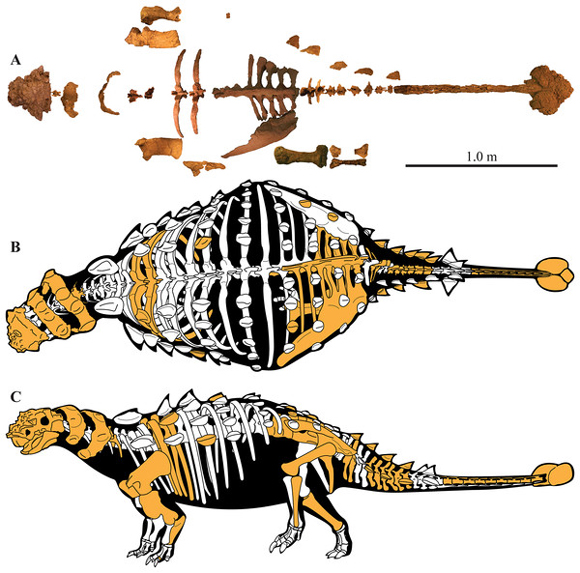
Picture credit: PeerJ
The first fossils were found in 2008, in a quarry which contained a mixed assemblage of vertebrate remains. Finds at the site, known as the Horse Mountain Gryposaur quarry, include a nearly complete skull of the hadrosaurid Gryposaurus, turtle fossil remains (Arvinachelys goldeni), a skull and postcranial remains of a new taxon of alligatoroid and a poorly preserved partial skull of a small theropod.
Akainacephalus Wanders Past Ancient Crocodilians
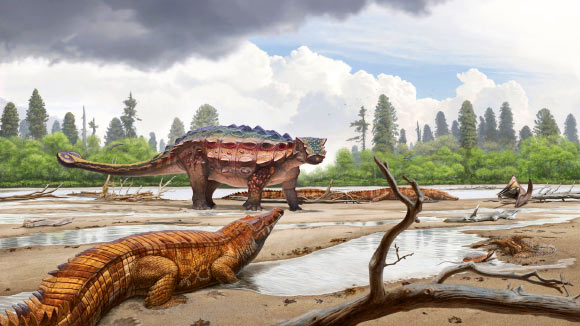
Picture credit: Andrey Atuchin (Denver Museum of Nature and Science)
The Amazing Kaiparowits Formation
The fossils were excavated from sediments associated with the Kaiparowits Formation, which provides a unique perspective on the biota of south/central Laramidia during the Campanian faunal stage of the Late Cretaceous. This thick succession of sandstones and mudstones was deposited at an unusually rapid rate within a time frame of less than two million years, making it one of the most rapidly deposited terrestrial formations in the world. Akainacephalus dates from 76.2 to 75.9 million years ago, as such it is one of the oldest ankylosaurids known from North America.
It is also the first documented example of ankylosaurid skull and postcranial bones from the Kaiparowits Formation. Although, some of the fossil bones are in a better condition than others, the fossils, including that amazing tail club are remarkably complete.
Views of the Caudal Vertebrae and the Tail Club of A. johnsoni
Picture credit: PeerJ
Dinosaur Immigrants from Asia
Those lumps and bumps on the skull (cranial ornamentation), are reminiscent of an armoured dinosaur from New Mexico (Nodocephalosaurus kirtlandensis), the researchers postulate that these dinosaurs might be closely related. However, it is worth noting that Nodocephalosaurus is around three million years younger than Akainacephalus. Both Nodocephalosaurus and Akainacephalus are also similar to Asian ankylosaurids such as Saichania chulsanensis, Pinacosaurus grangeri, and the spectacularly horned Minotaurasaurus ramachandrani. The discovery of Akainacephalus adds support to the idea that ankylosaurids migrated across an ancient land bridge from Asia into North America prior to 76 million years ago.
The addition of this new ankylosaurid taxon from southern Utah provides further information on ankylosaurid diversity and supports the theory regarding there being regional variations in dinosaur biota across Laramidia during the later stages of the Cretaceous.
Indicating that Ankylosaurids Migrated from Asia into North America (Akainacephalus johnsoni)
Picture credit: Andrey Atuchin (Denver Museum of Nature and Science)
Visit the Everything Dinosaur website: Everything Dinosaur.


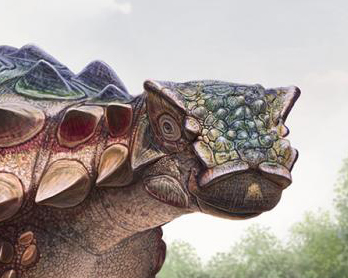
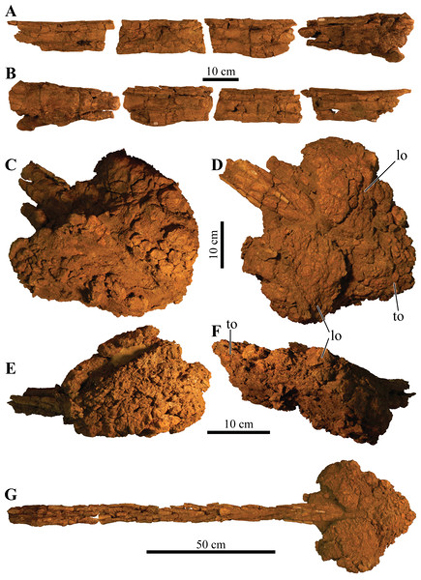
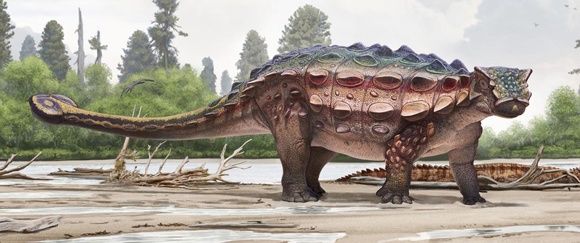




Leave A Comment